How to Treat Dry and Frizzy Hair? – Ultimate Care Guide
Did you know that over 70% of women struggle with dry and frizzy hair, leading to frustration and a constant battle for smooth, manageable locks? Taming unruly strands can feel like a never-ending journey, but with the right hair care routine and targeted treatments, you can bid farewell to dryness and frizz for good. This comprehensive Guide will equip you with the essential knowledge and practical solutions to revive your hair’s health and radiance.
Key Takeaways
- Understanding the causes of dry and frizzy hair is the first step to finding effective solutions.
- Establishing a consistent hair care routine with the right Products is crucial for maintaining healthy, hydrated hair.
- Natural remedies and professional treatments can provide deep nourishment and repair for damaged, frizzy hair.
- Adopting styling techniques that minimize heat damage and protect your hair’s moisture levels is essential.
- A healthy diet and lifestyle choices can significantly contribute to the overall condition of your hair.
Understanding Dry and Frizzy Hair: Causes and Characteristics
Dry and frizzy hair can be a frustrating issue for many individuals, but understanding the underlying causes and characteristics of this Hair Type is the first step towards effective management. Whether you’re dealing with persistent frizz or hair that feels brittle and lifeless, uncovering the root of the problem can help you find the right solutions.
Common Causes of Dryness
Dry hair can result from a variety of factors, including:
- Excessive use of heat styling tools, such as blow dryers, straighteners, and curling irons
- Exposure to harsh environmental conditions, like wind, sun, and dry air
- Frequent washing with shampoos that strip the hair of its natural oils
- Lack of moisture-rich treatments, like deep conditioning or leave-in conditioners
- Underlying health conditions or nutritional deficiencies that affect hair quality
Factors Contributing to Frizz
Frizzy hair occurs when the hair’s outer protective layer lifts and absorbs moisture, causing it to ruffle up. Damaged or dry hair is more prone to frizz, and certain hair types are more susceptible than others. Curly and thin, fine hair types often struggle with frizz, as their strands are more delicate and prone to dehydration.
It’s important to distinguish between frizzy and damaged hair, as frizzy hair is usually only dehydrated, while damaged hair requires different treatment. Incorporating hydrating Products and techniques can help manage frizz, while more intensive care may be needed for severely damaged hair.
Identifying Your Hair Type
Determining your hair type is crucial when it comes to treating dry and frizzy hair. Hair can be classified into four main categories: straight, wavy, curly, and coily. Each type has its own unique characteristics and needs, and understanding where your hair falls on this spectrum can Guide you towards the most effective Hair Care solutions.
By identifying your hair type and addressing the specific causes of dryness and frizz, you can take the first step towards achieving healthy, manageable hair. With the right strategies and products, it’s possible to tame even the most unruly tresses and enjoy a smoother, more polished appearance.
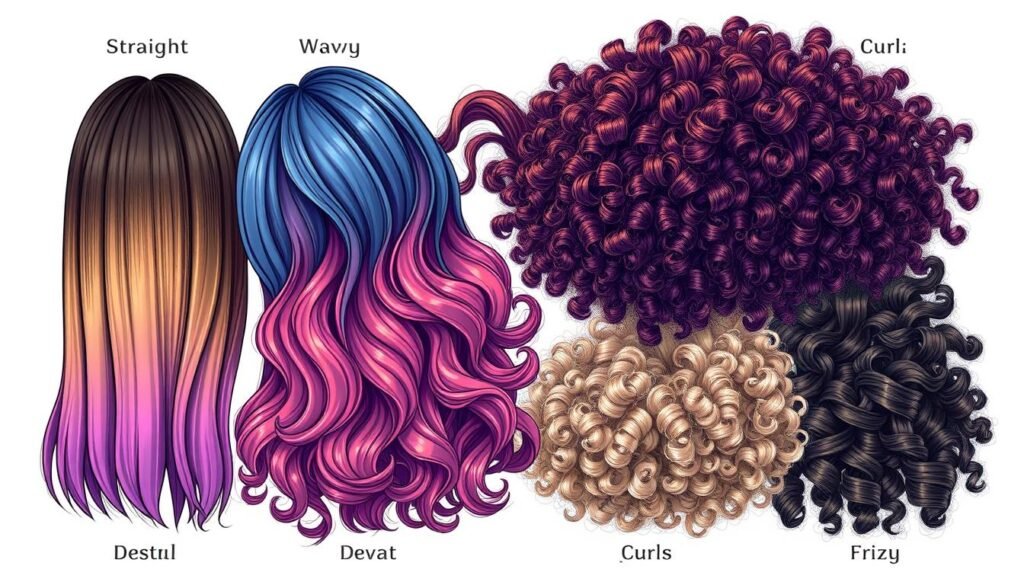
Essential Hair Care Practices for Hydration
Achieving soft, manageable hair goes beyond the occasional shampoo and conditioner routine. To combat dry, frizzy hair, it’s crucial to incorporate a comprehensive hair care routine that prioritizes hydration and nourishment.
Importance of Regular Washing
Dehydrated hair typically looks dull and feels rough, making it tough to style, and suffers from a lack of volume. Dry hair can result from excessive exposure to chemicals, heat styling, and overwashing. To maintain optimal moisture levels, it’s recommended to wash your hair no more than 2-3 times a week, using moisturizing hair treatments to replenish lost hydration.
Choosing the Right Shampoo and Conditioner
When selecting shampoo and conditioner for dry, frizzy hair, opt for sulfate-free formulas that are specifically designed to provide extra moisture and nourishment. Ingredients like hyaluronic acid, shea butter, and argan oil can help re-plump dehydrated strands, leaving hair soft, smooth, and manageable.
How Often Should You Wash Your Hair?
The frequency of washing your hair can greatly impact its overall condition. Overwashing can strip the hair of its natural oils, leading to increased dryness and frizz. It’s recommended to limit washing to 2-3 times a week, and to incorporate regular deep conditioning treatments to maintain optimal hydration levels.

“Silk or satin pillowcases can help protect hair from moisture loss during sleep, while heat styling tools can contribute to hair dehydration, and using heat protectants is recommended.”
By following these essential hair care practices, you can effectively combat dryness and frizz, leaving your locks soft, smooth, and healthy.
Choosing the Right Hair Products
When it comes to taming dry and frizzy hair, the right hair care products can make all the difference. From moisturizing shampoos to nourishing conditioners and leave-in treatments, the key is to choose formulas specifically designed to address these common hair concerns.
Best Moisturizing Shampoos for Dry Hair
For those with dry, brittle hair, look for shampoos that are rich in hydrating ingredients like argan oil, shea butter, and glycerin. Some top picks include the Dove Scalp+ Hair Therapy Density Boost Clarifying Shampoo, which is recommended for biweekly use, and the Pureology Smooth Perfection Shampoo, available for $37.00.
Recommended Conditioners for Frizz Control
To tame flyaways and reduce frizz, reach for conditioners infused with anti-frizz hair products like silicones and hair serum for frizz control. The Virtue Smooth Conditioner, priced at $44.00, and the IGK Crybaby Smoothing and Finishing Serum, available for $32.00, are excellent options.
The Role of Leave-In Treatments
Leave-in treatments are a game-changer for achieving smooth, frizz-free locks. Look for formulas containing argan oil, keratin, or coconut oil to deeply nourish and hydrate your hair. The Kérastase Elixir Ultime Hydrating Hair Oil Serum, priced at $32.00, and the Rene Furterer Karité Intense Overnight Nourishing Treatment are two standout options.
By incorporating these anti-frizz hair products and hair serum for frizz control into your routine, you can bid farewell to dryness and tame unruly frizz, leaving your hair smooth, healthy, and manageable.
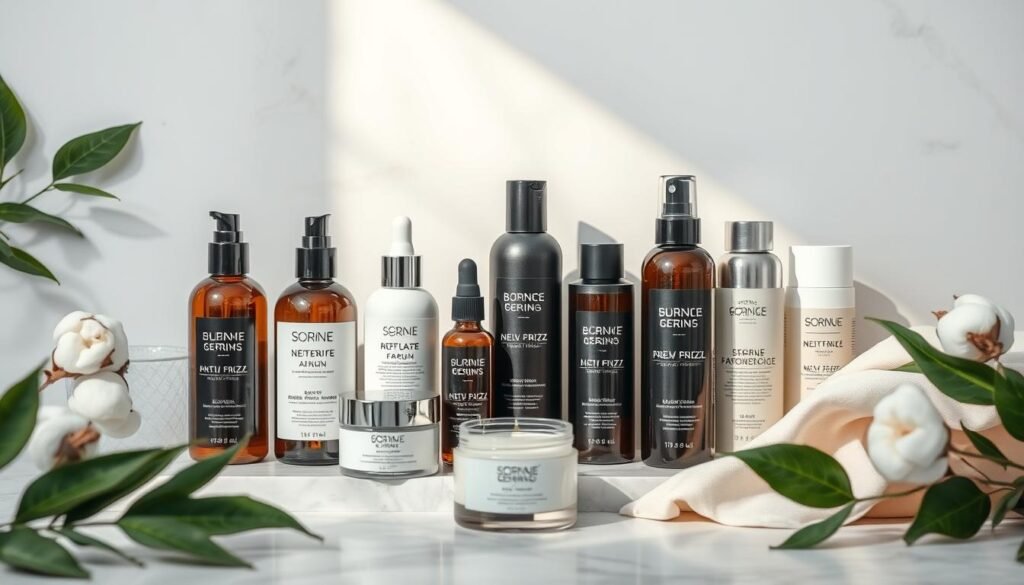
Natural Remedies for Dry and Frizzy Hair
While professional hair care products are often the most effective solution for taming dry and frizzy hair, natural remedies can also provide significant benefits. By incorporating DIY hair masks, nourishing oils, and herbal rinses into your routine, you can restore moisture, enhance smoothness, and reduce unwanted flyaways.
DIY Hair Masks for Deep Conditioning
Creating your own hair masks at home is a cost-effective way to deliver intense hydration and nourishment to parched locks. Some of the most effective ingredients for dry, frizzy hair include:
- Avocado, rich in vitamins A and E, which helps to hydrate and tame frizz
- Egg, high in saturated fats, biotin, and vitamins, for healthier, shinier hair
- Coconut oil, easily absorbed due to its lauric acid content, to add moisture and reduce protein loss
Oils That Nourish and Hydrate
Incorporating nourishing oils into your hair care routine can make a significant difference in combating dryness and frizz. Argan oil, rich in oleic and linoleic acids, serves as a powerful moisturizing agent, while almond oil is known for its ability to nourish and reduce frizz while adding shine and a pleasant scent.
Herbal Rinses for Smoothness
Beyond masks and oils, herbal rinses can also be an effective natural remedy for frizzy hair. Apple cider vinegar mixed with warm water, for example, can help reduce frizz when applied topically for 1-3 minutes before rinsing with cool water. The slightly acidic pH of the vinegar helps to close the hair cuticles, resulting in a smoother, more manageable appearance.
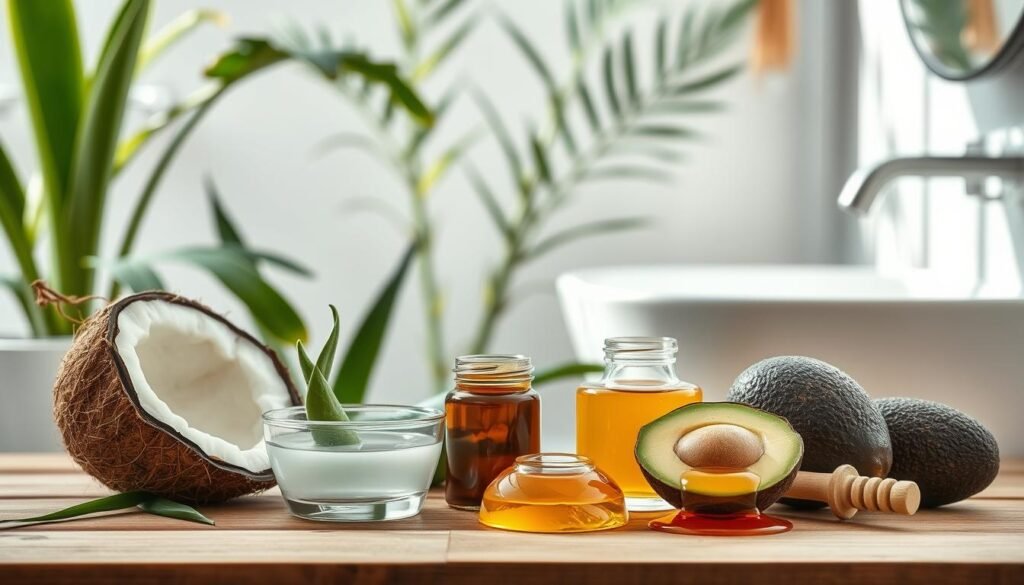
By incorporating these natural remedies into your hair care routine, you can achieve healthier, more manageable locks, reducing the appearance of dryness and frizz without relying solely on commercial products.
Styling Techniques to Reduce Frizz
Managing frizzy hair can be a real challenge, but with the right styling techniques, you can minimize the appearance of pesky flyaways and unruly locks. The key is to focus on protecting your hair from heat damage and using the right tools for a smooth, polished look.
Importance of Heat Protection
Excessive heat from styling tools like blow dryers, straighteners, and curling irons can be a major contributor to dry, frizzy hair. To combat this, always apply a heat protectant before using any hot styling tools. These products create a barrier to shield your strands from the damaging effects of high temperatures.
Best Tools for Styling Dry Hair
- Opt for a wide-tooth comb or a detangling brush to gently work through knots and tangles, preventing further damage and frizz.
- Use a microfiber towel or an old t-shirt to dry your hair, as they are gentler on delicate strands and reduce friction that can lead to frizz.
- Consider investing in a quality ionic hair dryer or a diffuser attachment to style your hair without excessive heat exposure.
How to Minimize Damage While Styling
When styling your hair, be sure to use the lowest heat setting possible and limit the amount of time you expose your hair to heat. Avoid over-brushing, which can disrupt the hair cuticle and contribute to frizz. Instead, focus on using your fingers or a wide-tooth comb to gently style and smooth your hair.
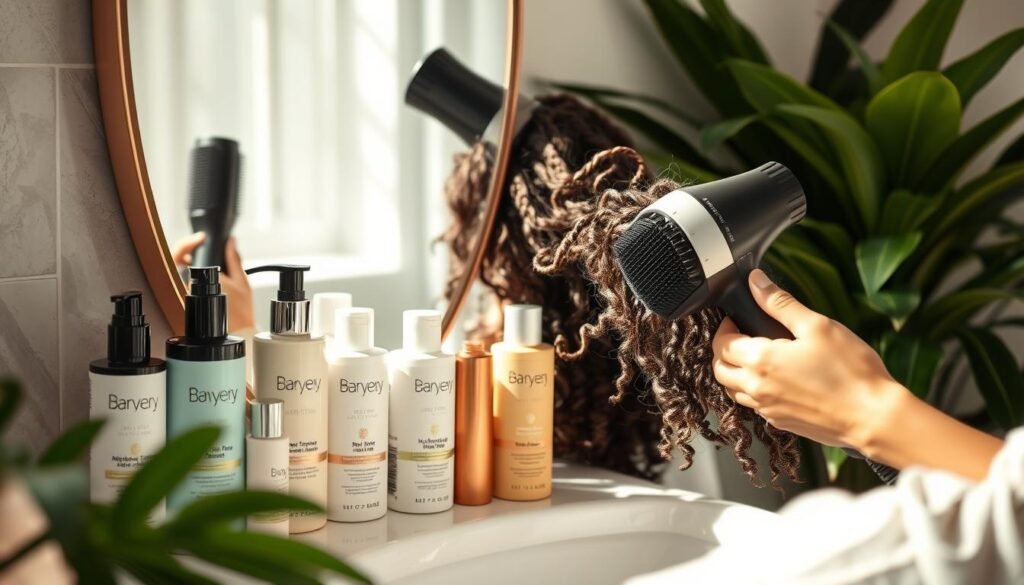
By following these simple styling techniques, you can maintain your hair’s natural moisture and minimize the appearance of frizz, keeping your locks looking sleek and manageable.
The Role of a Healthy Diet in Hair Health
A balanced diet rich in essential nutrients can have a significant impact on the health and appearance of your hair. Key vitamins, minerals, and healthy fats play a crucial role in nourishing your hair from within, promoting optimal growth, strength, and shine. By incorporating the right foods into your hair care routine, you can achieve lustrous, hydrated locks and minimize issues like dryness and frizz.
Key Nutrients for Nourishing Hair
To keep your hair healthy and resilient, focus on consuming a diet that is abundant in the following key nutrients:
- Protein: Hair is primarily made of protein, so ensuring adequate protein intake through foods like eggs, lean meats, and legumes is essential for healthy hair growth.
- Iron: Iron deficiency can lead to hair loss, so incorporate iron-rich foods like spinach, lentils, and red meat into your diet.
- Omega-3 fatty acids: Found in foods like salmon, flaxseeds, and walnuts, omega-3s help nourish the scalp and promote hair health.
- Vitamin E: This antioxidant-rich vitamin, found in almonds, sunflower seeds, and avocados, helps protect hair from damage and promote shine.
Foods to Incorporate for Better Hair Condition
To ensure your hair is getting the nutrients it needs, incorporate the following foods into your regular diet:
- Salmon and other fatty fish for their omega-3 content
- Leafy greens like spinach and kale for their iron and vitamin E
- Eggs and Greek yogurt for their protein-rich properties
- Avocados and nuts for their healthy fats and vitamin E
- Legumes, lentils, and beans for their iron and protein
Staying Hydrated for Optimal Results
Maintaining optimal hydration is also key for healthy, vibrant hair. Aim to drink at least 8-10 glasses of water daily to keep your hair and scalp well-nourished and hydrated. Proper hydration can help prevent dryness, brittleness, and frizz, resulting in a more manageable and lustrous hair care routine.
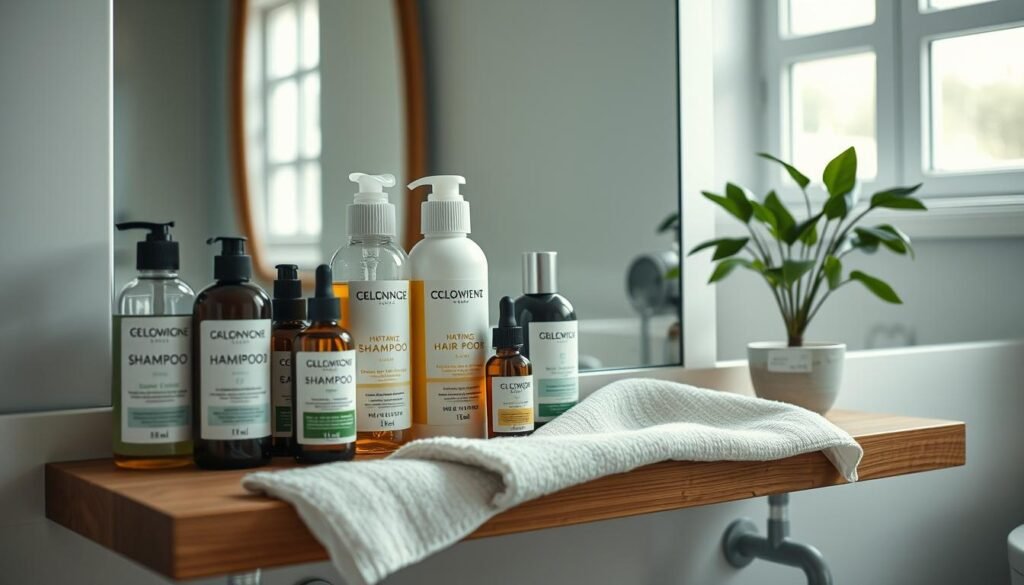
“Healthy hair starts from within. By nourishing your body with the right nutrients, you can achieve the hair of your dreams.”
– Trichologist, Philip Kingsley
Professional Treatments for Dry and Frizzy Hair
When it comes to taming dry, frizzy hair, professional treatments can provide intensive care and long-lasting results. From hair spa treatments to keratin treatments, these specialized services can transform the appearance and health of your locks.
What to Expect from a Hair Spa Treatment
A hair spa treatment is a comprehensive salon service that targets various hair concerns, including dryness and frizz. During a hair spa session, your stylist will thoroughly cleanse, condition, and nourish your hair with a series of specialized products and techniques. This deep conditioning process can leave your hair feeling softer, smoother, and more manageable.
Benefits of Keratin Treatments
Keratin treatments have become a popular solution for individuals struggling with deep conditioning for dry hair and anti-frizz hair products. These treatments involve the application of a keratin-based formula that works to smooth and straighten the hair cuticle, reducing frizz and enhancing shine. The effects of a keratin treatment can last for up to six months, providing long-lasting results for people with unruly, frizzy hair.
The Impact of Regular Haircuts
Regular haircuts are an essential aspect of maintaining healthy, hydrated hair. Trimming away split ends and damaged sections can help prevent further breakage and promote the overall condition of your hair. By getting a trim every 6-8 weeks, you can ensure your hair remains strong, vibrant, and free from excessive dryness or frizz.
Professional treatments, combined with a personalized hair care routine, can be a game-changer for individuals seeking to tame their dry, frizzy locks. Whether it’s a nourishing hair spa, a transformative keratin treatment, or regular trims, these specialized services can help you achieve the smooth, manageable hair you desire.
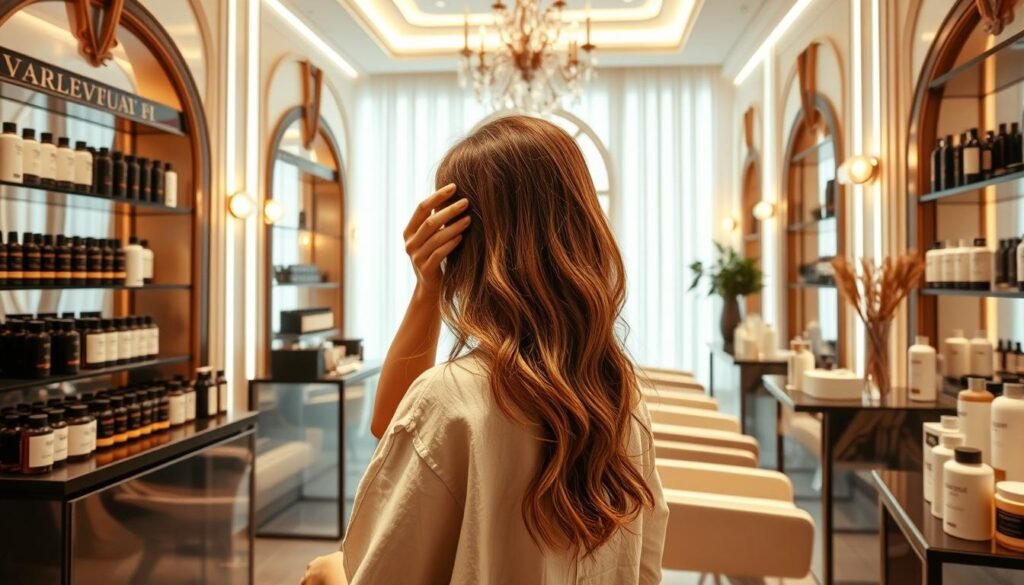
Environmental Factors That Affect Hair
Maintaining healthy, frizz-free hair can be a constant battle, as various environmental factors can significantly impact hair texture and manageability. From humidity to sun exposure and indoor heating, understanding how these elements influence your hair is crucial for developing an effective hair care routine.
How Humidity Affects Hair Texture
High humidity levels can wreak havoc on hair, causing it to swell and become unruly. The excess moisture in the air penetrates the hair shaft, disrupting the natural alignment of the hair cuticles. This leads to the development of frizz, making it challenging to achieve a sleek, polished look. Using a hair serum for frizz control can help lock in moisture and tame flyaways.
Protecting Hair from Sun Damage
Exposure to ultraviolet (UV) rays from the sun can have a detrimental effect on hair health. The sun’s rays can break down the protein structure of the hair, leading to dryness, brittleness, and discoloration. To Manage frizzy hair and protect your locks, it’s essential to use hair care products with built-in UV filters, wear a hat or scarf when outdoors, and limit prolonged sun exposure.
Indoor Heating and Its Effects
The dry air produced by indoor heating systems can also contribute to hair woes. This dry environment can strip the natural oils from your hair, leaving it parched and prone to static electricity. Incorporating a humidifier into your living space and using a nourishing hair serum for frizz control can help counteract the drying effects of indoor heating.
By understanding how environmental factors influence hair texture and frizz, you can adjust your hair care routine accordingly to maintain healthy, manageable locks throughout the year.
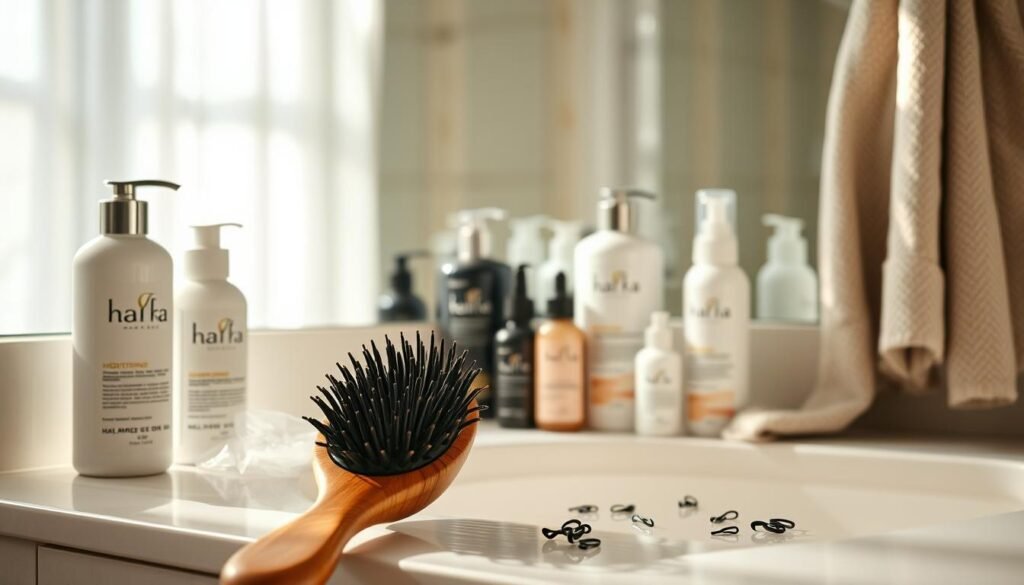
Seasonal Hair Care Tips
Your hair care routine should evolve with the seasons to keep your locks healthy and vibrant throughout the year. From the dryness of winter to the humidity of summer, understanding how to adjust your regimen can make a significant difference in the appearance and feel of your hair.
Winter Care Strategies
The winter months can be particularly harsh on hair, leading to dryness, brittleness, and increased breakage. To combat these challenges, focus on deeply moisturizing your hair with richer, more hydrating products. Incorporate weekly deep conditioning treatments to replenish lost moisture and strengthen strands. Additionally, reducing your use of hot styling tools can help prevent further damage during the drier winter climate.
Summer Hair Protection Techniques
Summer brings its own set of hair care concerns, from sun exposure to chlorine-filled pools. Protect your hair by using UV-filtering products, wearing hats or scarves, and limiting time in the water. Opt for gentle, moisturizing shampoos and conditioners to counteract the drying effects of salt water and chlorine. Stay away from heavy styling products that can weigh down your hair and contribute to frizz in the humidity.
Adjusting Your Routine for Rainy Weather
Rainy days can wreak havoc on frizz-prone hair. To combat humidity-induced flyaways, incorporate anti-frizz serums, creams, or oils into your routine. Avoid over-washing your hair, as this can strip away natural oils and lead to even more frizz. Instead, focus on refreshing your style with a moisture-locking hair mist or light, flexible-hold hairspray.
By tailoring your hair care routine to the changing seasons, you can maintain healthy, vibrant frizzy hair remedies year-round. With the right products and techniques, you can weather any climate and keep your hair looking its best.
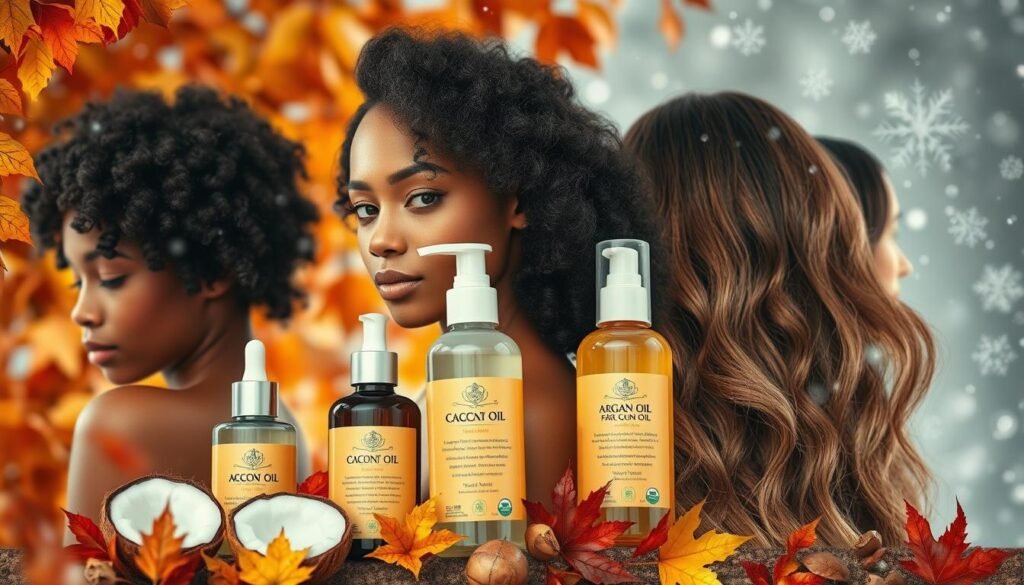
Lifestyle Changes for Healthier Hair
Achieving healthy, vibrant hair goes beyond just using the right products – it’s also about making lifestyle adjustments that support hair growth and resilience. By addressing factors like stress, sleep quality, and hair care habits, you can nurture your locks from the inside out and achieve the smooth, frizz-free tresses you desire.
Reducing Stress for Better Hair Condition
Chronic stress can wreak havoc on your hair, triggering hormonal imbalances that disrupt the hair growth cycle and lead to increased shedding and thinning. Incorporate stress-reduction techniques like meditation, yoga, or deep breathing exercises into your daily routine to help your body and mind stay balanced. Engaging in these activities can promote a healthier scalp environment and encourage stronger, more lustrous hair.
The Importance of Sleep for Hair Health
Quality sleep is essential for hair growth and regeneration. During sleep, your body undergoes cell repair and rejuvenation processes that support healthy hair development. Aim for 7-9 hours of sleep per night and establish a consistent bedtime routine to ensure your body has the time it needs to restore and revitalize your hair from within. Consider using silk or satin pillowcases, as they can help reduce friction and prevent hair breakage during the night.
How to Avoid Hair Breakage
Minimizing hair breakage is crucial for maintaining the overall health and appearance of your tresses. Avoid excessive heat styling, such as blow-drying, and opt for gentler techniques like air-drying or using low-heat settings. Additionally, be mindful of how you handle your hair, especially when it’s wet, as this is when it’s most vulnerable to damage. Gently detangle with a wide-tooth comb or brush, and avoid rubbing or twisting your hair aggressively.
By addressing lifestyle factors and implementing mindful hair care practices, you can create the foundation for healthier, more manageable hair that is less prone to dryness and frizz. Remember, small changes can lead to big improvements in the long run.
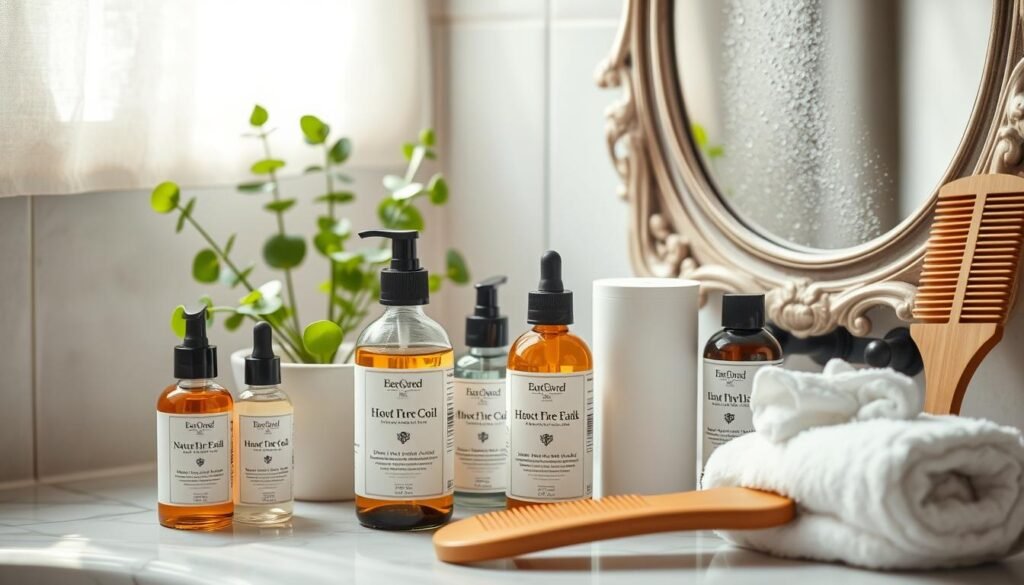
Product Application Techniques for Maximum Hydration
Proper application of moisturizing hair treatments and hair masks is crucial for achieving optimal hydration and reducing frizz. By following these techniques, you can ensure that your hair receives the maximum benefits from these nourishing products.
how to Properly Apply Conditioner
When applying conditioner, be generous with the amount. Focus on applying it from the mid-lengths to the ends of your hair, where it is most prone to dryness and damage. Gently massage the conditioner into your hair, ensuring even distribution. Leave the conditioner on for the recommended time, typically 3-5 minutes, before rinsing thoroughly.
Techniques for Applying Hair Masks
- Start by sectioning your hair into manageable parts to ensure even coverage.
- Apply the hair mask for dry hair generously, from roots to ends, using your fingers or a wide-tooth comb.
- Cover your hair with a shower cap or a warm towel to help the mask penetrate deeper.
- Leave the mask on for the recommended time, usually 15-30 minutes, before rinsing it out.
Best Practices for Using Oils
- Apply moisturizing hair treatments as the final step in your routine, when your hair is damp but not dripping wet.
- Dispense a small amount of oil into your palms and rub them together to warm the oil.
- Gently work the oil through the mid-lengths and ends of your hair, avoiding the roots.
- Focus on areas that are particularly dry or prone to frizz, such as the ends of your hair.
By following these application techniques, you can ensure that your hair receives the maximum hydration and nourishment from your moisturizing hair treatments and hair masks, helping to tame frizz and restore your hair’s natural shine and smoothness.
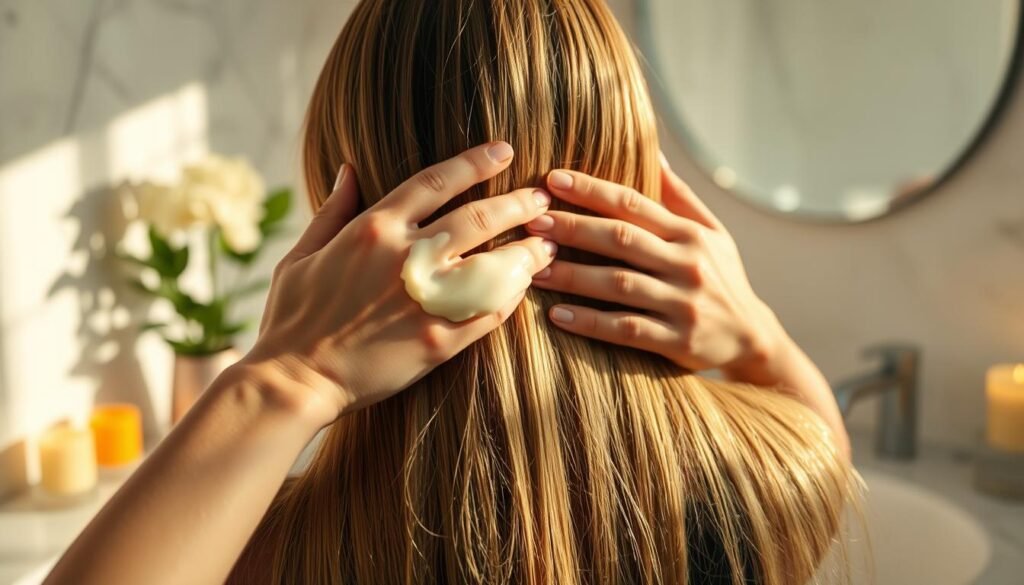
“The key to achieving deeply nourished, hydrated hair is in the application. Take the time to properly work these moisturizing products into your hair, and you’ll see the difference in the results.”
Maintaining Long-Term Health for Your Hair
Achieving healthy, frizz-free hair is an ongoing journey that requires a personalized approach. By creating a tailored hair care routine based on your unique hair type and needs, you can effectively address dryness and combat persistent frizz for long-lasting results.
Creating a Personalized Hair Care Routine
Begin by evaluating your current hair care regimen and identify areas that need improvement. Consider factors such as your hair texture, porosity, and any specific concerns like damage or color-treated hair. Experiment with different shampoos, conditioners, and styling products to determine what works best for your hair. Remember, what works for someone else may not necessarily be the perfect solution for your tresses.
Tracking Your Hair’s Progress
Consistently follow your personalized hair care routine and closely observe the changes over time. Take note of any improvements in manageability, shine, and reduction in frizz. Be patient and allow your hair the necessary time to respond to the new products and techniques. Regular trims can also help maintain the health of your hair by eliminating split ends and promoting growth.
When to Consult a Hair Care Professional
If despite your best efforts, you continue to struggle with persistent dryness, unmanageable frizz, or other hair-related concerns, it may be time to consult a hair care professional. A qualified stylist or dermatologist can provide personalized advice, recommend targeted treatments, and help you identify any underlying issues that may be contributing to your hair woes. With their expertise, you can achieve the healthy, vibrant hair you’ve been seeking.
FAQ
What are the common causes of dry and frizzy hair?
Dry and frizzy hair can be caused by a variety of factors, including damage to the hair’s outer protective layer, lack of moisture, and environmental conditions like humidity and sun exposure.
How often should I wash my hair to prevent further dryness and frizz?
It’s recommended to limit washing to 2-3 times a week to prevent stripping the hair’s natural oils. Choose sulfate-free shampoos and conditioners that provide extra moisture to maintain hydration.
What types of hair products are best for treating dry and frizzy hair?
Look for moisturizing shampoos, conditioners for frizz control, and leave-in treatments specifically formulated for dry and frizzy hair. Products containing ingredients like argan oil can provide extra moisture and control frizz.
Can natural remedies help with dry and frizzy hair?
Yes, DIY hair masks and the use of natural oils like argan oil can provide deep conditioning and help to reduce frizz. However, consistent use of professional products designed for dry and frizzy hair is often more effective than occasional home remedies.
How can I minimize damage and frizz when styling my hair?
Minimize heat styling, use lower temperature settings, and always apply a heat protectant. Detangle hair gently with a wide-tooth comb and dry it with a microfiber towel or old t-shirt to reduce friction and frizz.
What role does diet and nutrition play in maintaining healthy, frizz-free hair?
A balanced diet rich in key nutrients like protein, vitamins, and healthy fats can improve hair health from within. Staying hydrated is also crucial for maintaining optimal hair condition.
Can professional treatments help with dry and frizzy hair?
Yes, treatments like hair spas and keratin treatments can provide intensive Care for dry and frizzy hair. Regular haircuts can also help maintain hair health by removing Split Ends and promoting overall hair health.
How can environmental factors affect my hair and what can I do about it?
Environmental factors like humidity, sun exposure, and indoor heating can significantly impact hair texture and frizz. Use hair serums with UV filters to protect hair from sun damage, and adjust your hair care routine based on environmental conditions to maintain smooth, frizz-free hair.
Should I adjust my hair care routine based on the season?
Yes, it’s important to adapt your hair care routine to different seasons. In winter, focus on extra moisturizing, while during summer, protect hair from sun damage. For rainy weather, use anti-frizz products to combat humidity-induced frizz.
How can lifestyle factors affect my hair health and how can I address them?
Factors like stress and sleep quality can affect hair health. Implement stress-reduction techniques and ensure adequate sleep. Use silk or satin pillowcases to reduce friction and prevent hair breakage during sleep.






